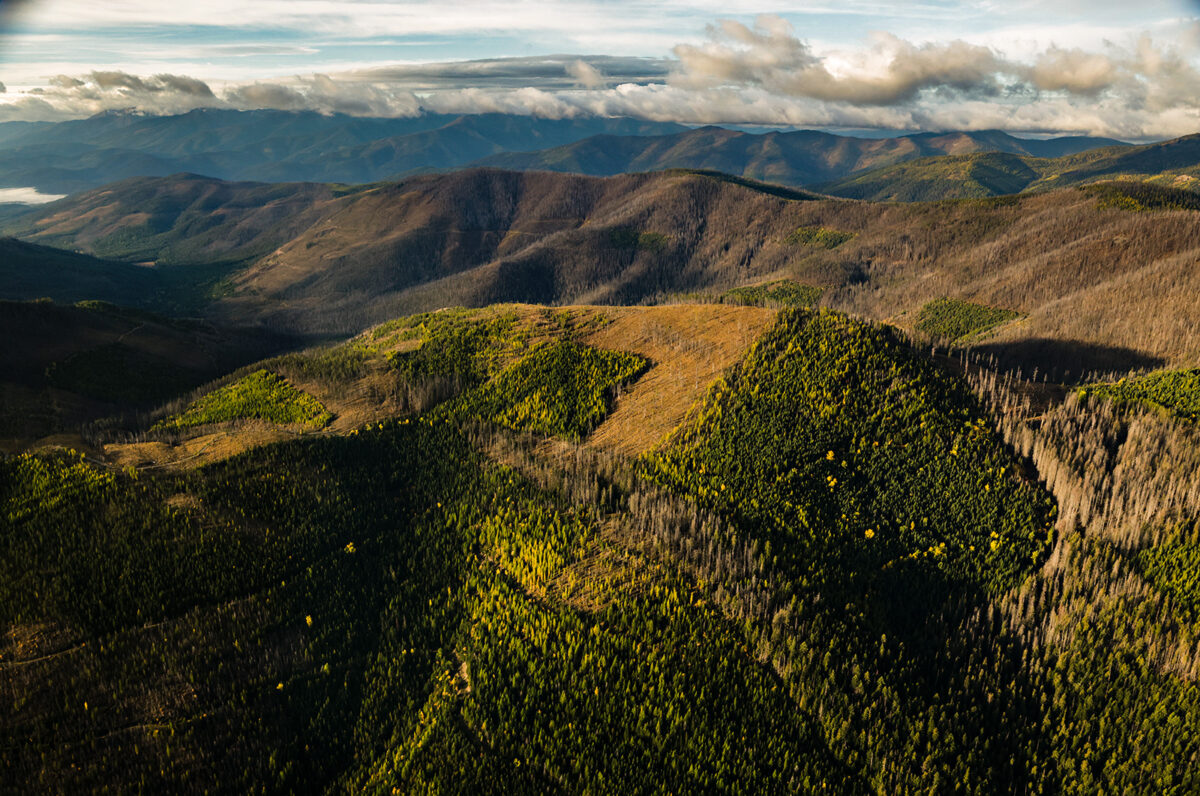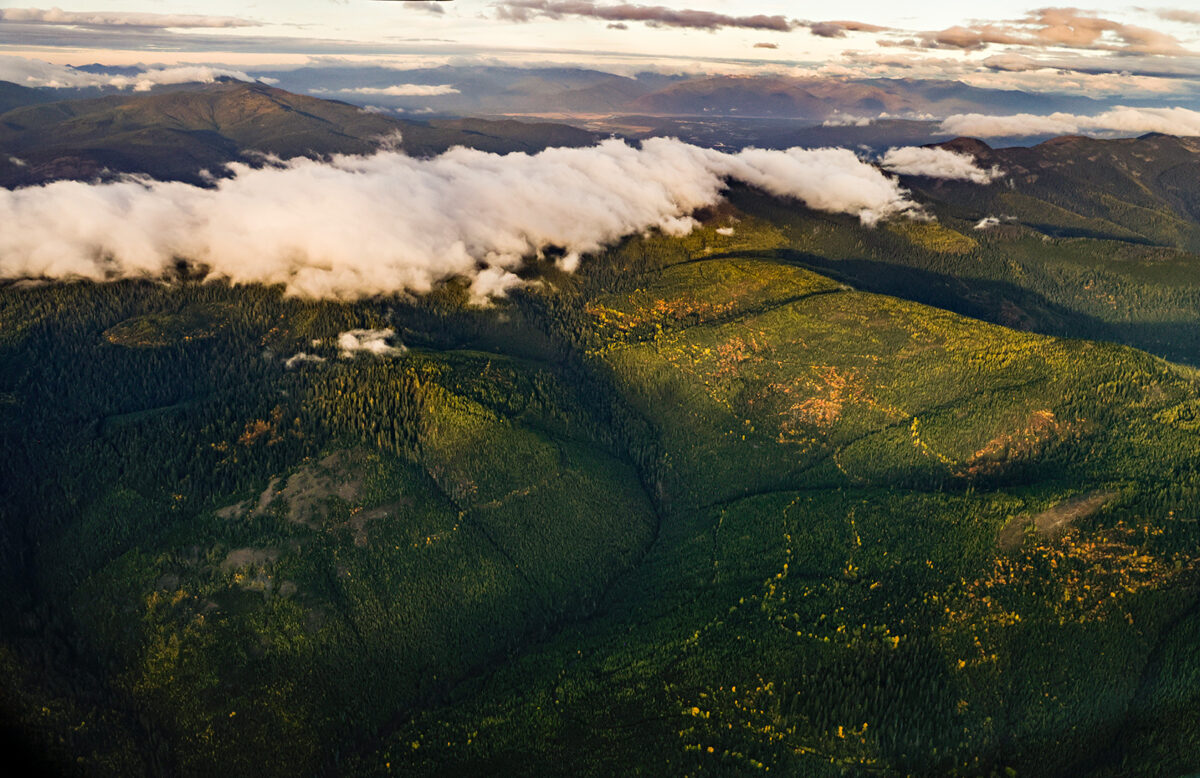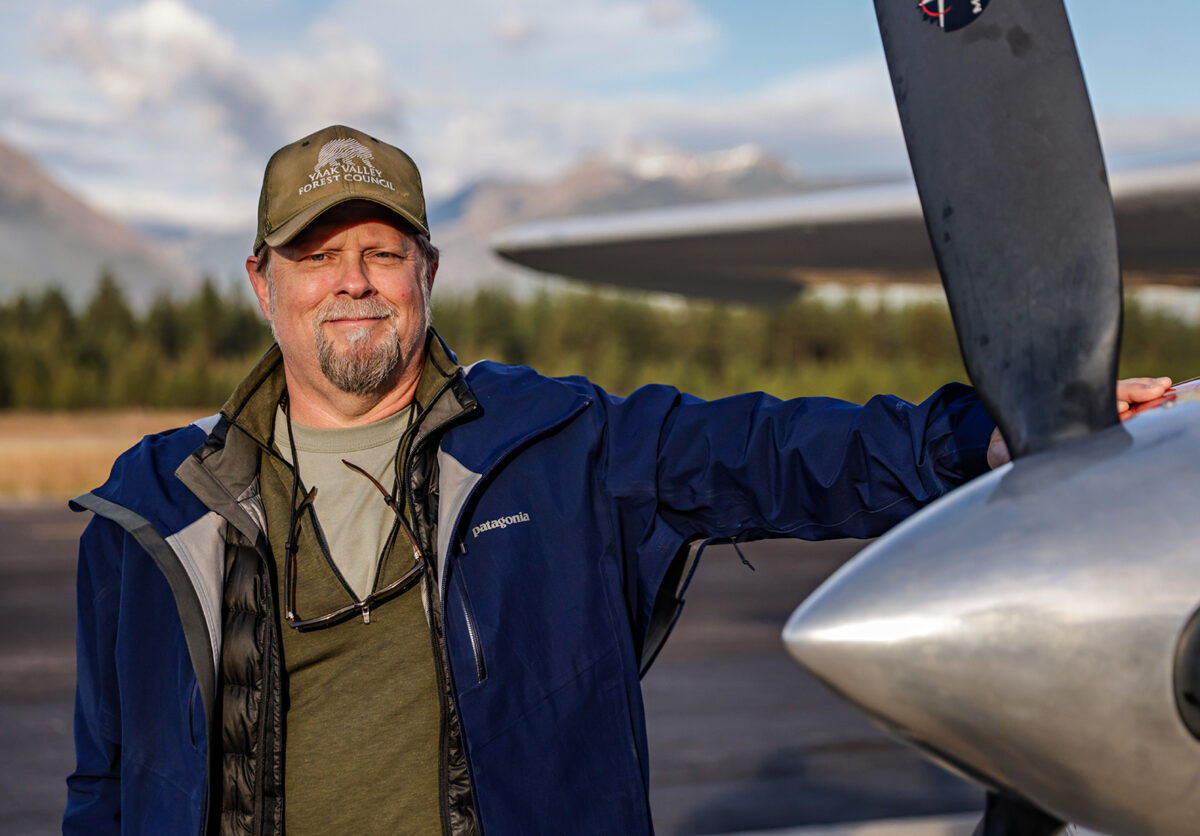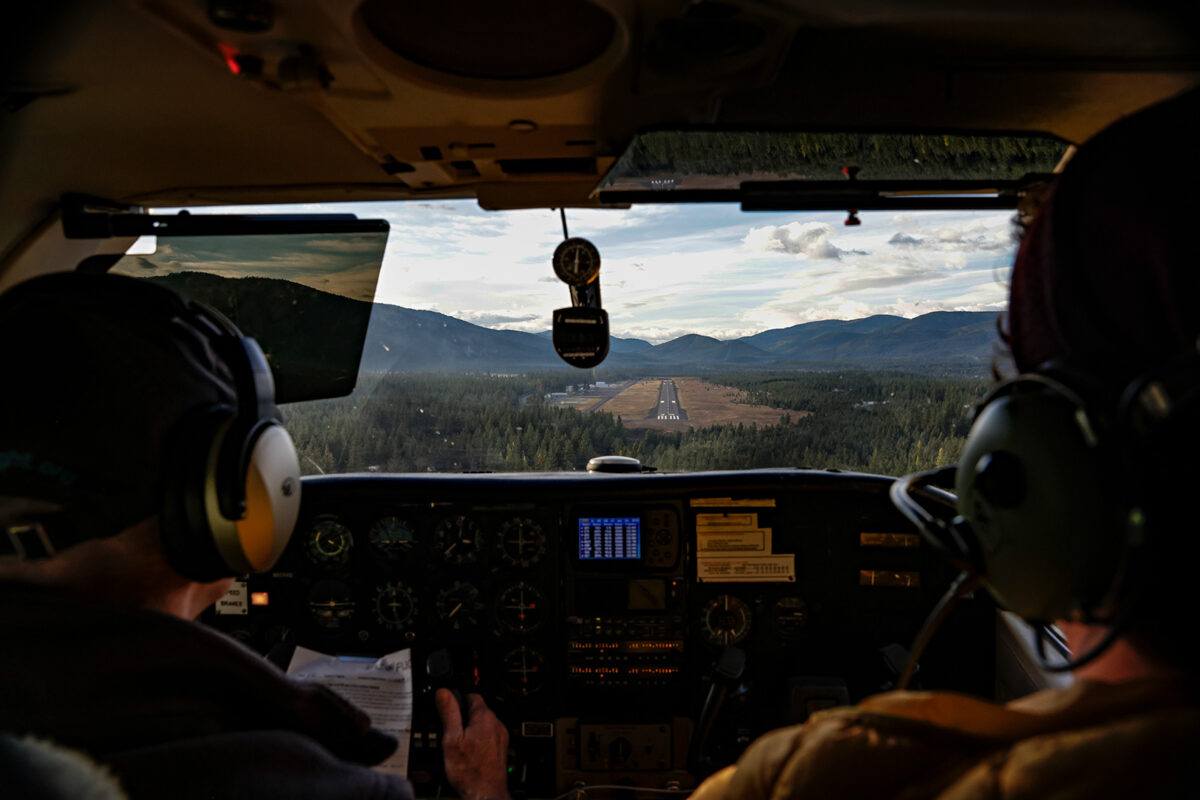The Yaak Valley Is Ground Zero for Montana’s Environmental Future
As conservation groups emerge from court victorious in their mission to stop controversial logging projects, the future of the Yaak Valley and its timber industry remains in limbo
By Anusha Mathur
Thousands of feet above northwest Montana’s Yaak Valley, a six-seater EcoFlight airplane soared through cloudy skies. As passengers pressed camera lenses up to the vehicle’s port-hole shaped windows to photograph the dense forest below, Anthony South, Headwaters Director for the Yaak Valley Forest Council, narrated the journey.
“We’ll be going over the Kootenai River in between the Purcell Mountains and the Cabinet Mountains Wilderness,” South said. “Down there on the right, you can see that really weird plantation style planting, a lot of that was cleared by bulldozer … the river, the train tracks, and the highway serve as a major fragmentation for the grizzly bear populations in the Cabinet-Yaak ecosystem.”
As environmental protection becomes increasingly politicized, the nation is paying special attention to the Yaak Valley – northwest Montana’s increasingly high-profile environmental battleground. Ongoing litigation in the region has serious implications for how densely forested states strike a balance between species conservation, climate change mitigation and supporting existing industries that keep working-class communities alive.

From Above
On the ground, working forests can appear thick and endless, but viewed from above, an unbroken swath of dense trees abruptly yields to barren ground. Jagged serrations form a patchwork of cuts, delineating the U.S. Forest Service’s (USFS) five major logging projects that all border one another in the Yaak Valley. The 72,550-acre NE Yaak project, 56,000-acre Buckhorn project, and 34,911-acre O’Brien project are currently underway while the 95,412-acre Black Ram project and 56,009-acre Knotty Pine project are being legally challenged.
The most contentious of these is the Black Ram, which overlaps with the Yaak’s tallest peak in the valley. Its litigation has garnered by far the most attention as several waves of lawsuits filed by the Center for Biological Diversity, Alliance for the Wild Rockies, Yaak Valley Forest Council, WildEarth Guardians and Native Ecosystems Council have challenged the logging, arguing their potential to cause irreparable harm to old-growth trees and a vulnerable subpopulation of grizzly bears.
The controversy reached its boiling point in August when U.S. District Court Judge Donald W. Molloy ruled that the USFS failed to adequately account for the Black Ram’s negative consequences on the Yaak’s grizzly bear population and climate change more generally. The ruling threw a wrench in the USFS’ plans, giving them two options – address the judge’s concerns or appeal the ruling to a higher court within 60 days.
First proposed in 2017 and approved in 2022, the USFS outlined the Black Ram project with the goal of harvesting timber, treating fuels, conducting prescribed burns, restoring streams, and improving recreation.
The forest management is a routine part of USFS work; however, the most significant complicating factor in the Yaak is grizzly bears. The Yaak Valley is home to one of only six grizzly bear recovery areas in the lower 48 states, known as the Cabinet-Yaak Ecosystem. The USFS conceded that Black Ram’s call for 3,902 acres of logging would affect the 18 to 25 bears left in the Yaak portion of this ecosystem, with an additional 25 to 30 bears residing in the Cabinet Mountains, according to state and federal wildlife managers.
Among the biggest threats to the Cabinet-Yaak grizzly bears, state and federal wildlife managers say, is habituation to humans or human-food conditioning. But wildlife advocates say that another hurdle to recovering the vulnerable populations, as mandated by the Endangered Species Act, has been logging roads. Roads allow hunters and recreationists easy access and increase the opportunity for human-bear conflicts, they say, and the Black Ram would authorize 3.3 miles of new permanent road construction and the use of 90.3 miles of existing roads.
Ultimately, Molloy sided with the conservation groups on the grounds that the Black Ram Project violated the National Environmental Policy Act and Endangered Species Act, agreeing that the defendants “failed to use the best available science in establishing an environmental baseline of the grizzly bear in the Project area” and “relied on a flawed biological opinion in approving the Project.”
Referencing the Forest Service’s own data illustrating that road closures are ineffective at preventing illegal access and pose a threat to recovering grizzlies, Molloy added that the federal agency ignored the recent uptick in female grizzly bear deaths, which would have changed its impact analysis. The USFS and U.S. Fish and Wild Service (FWS) relied on a statistical method for estimating numbers of grizzlies living in the area to demonstrate population increases without accounting for field report data that showed population numbers decreasing.
“While the FWS is not required to use the minimum counts method to create an environmental baseline, it may not ignore the issue of female mortality altogether because to do so ignores an important aspect of the problem that the agency itself acknowledges,” Molloy wrote. “Statistical modeling is scientifically accurate, but documented deaths of female bears cannot be ignored.”
Molloy further criticized the USFS and FWS for not conducting an in-depth climate study. He wrote that the agencies did not explain their determination using high-quality analysis or account for the short-term carbon losses that would result from cutting old-growth trees.
“USFS generally concludes that carbon as a result of the Project’s activities make up ‘only a tiny percentage of forest carbon stocks of the Kootenai National Forest and an infinitesimal amount of total forest stocks of the United States. Under this logic, USFS could always skirt ‘hard look’ analysis when doing a carbon impacts review by breaking up a project into small pieces and comparing them to huge carbon stocks.”
While Molloy’s decision marked a significant victory for the conservation groups, it’s far from the end of their fight, and in the months since the ruling they’ve ramped up community-awareness initiatives. The Yaak Valley Forest Council has forged a partnership with EcoFlight to organize educational flyovers for members of the public.
Ted Zukoski, senior attorney at the Center for Biological Diversity, argues that opposing the Black Ram is an easy cause for the public to rally behind – the litigation clearly outlines the harm to grizzly populations and centuries-old trees.
“Litigation is one tool in the toolbox, but public support, public outcry, and public involvement are also critical tools,” Zukoski said. “It is always better to be involved in a campaign that involves not just lawyers fighting in the courtroom, but people raising their voices on the outside.”

Justifications from the Authorities
The Forest Service pushes back, arguing that plaintiffs in these cases weave stories of the federal agency’s malicious intent where there is none. LaRona Rebo, public affairs officer for the Kootenai National Forest, and Sam Martin, Three Rivers District Ranger, explain the Forest Service’s projects follow the Kootenai National Forest Management Plan, which was approved in 2015 and created in collaboration with local groups and key stakeholders.
“The purpose of harvest treatments is to produce healthy, resilient forests,” Rebo said. “While every project can have a varied purpose and need, the forest plan lays out the parameters to which each area is managed. This enables a balance of active management and natural disturbances to occur across the landscape. Timber harvest is one of many tools used to accomplish resource objectives.”
In 2018, the Trump Administration directed regional foresters to increase logging volume by 31%, leading to more logging nationwide. Each year, Rebo said Montana’s forests are assigned “timber targets” from the Washington office – directions for how much wood is to be harvested. Rebo said these targets are key to maintaining healthy forests. With several Yaak Valley logging projects now halted, she said it will be difficult for the Kootenai Forest to meet its goals.
“We use the best available science, rigorous site-specific environmental analysis, and extensive public engagement to guide our decision-making,” she said. “Active forest management, including thinning and fuels reduction by selective timber harvest, is an important approach to conserve and protect mature and old-growth forests threatened by uncharacteristic fire or other disturbances.”
Other stakeholders say that limiting logging opportunities in the Yaak Valley will diminish forest health. Julia Altemus, the Montana Wood Products Association’s executive director, said that the litigation in the Yaak Valley has already had drastic ramifications on this year’s production cycle.
“Normally, the Kootenai would produce about 70 million board feet per year and they’re down to maybe 5 million board feet,” Altemus said. “It has definitely impacted how much fiber gets from the forest to the mills. It’s hard to run a mill when you never know where your fiber is going to come from.”
Conservation groups express frustration over this perspective, calling it an outdated and oversimplified approach to forest management.
“We find ourselves in the ancient position of logging versus grizzlies,” Yaak Valley Forest Council Interim Executive Director Rick Bass said. “Just do your job, Forest Service. You can do two things – you can do vegetative management and you can recover grizzlies. It’s not that complicated.”

On the Ground
With high-profile environmental activists taking a fierce and vocal stand, opposition to the Black Ram Project has extended far beyond Montana’s borders.
In addition to his work with the Yaak Valley Forest Council, Bass is also a well-known writer and environmental activist. In mid-October, he boarded a plane from Montana to Portland, Maine for an event called Climate Aid: The Voice of the Forest, a benefit to celebrate the recent court ruling to halt the Black Ram Project and raise money to protect old-growth trees on federal public lands.
Also making this over four-hour journey was the Black Ram Guitar – an instrument fashioned by a Montana luthier and made from the wood of an ancient Yaak Valley spruce tree, which had been damaged by the widening of a logging road for the Black Ram project. In Maine, Bass was joined by several environmental activists as well as artists, including Maggie Rogers, who played the guitar for the crowd.
“She’s brand new, less than one-year-old and she’s got this ancient sound already,” Bass said. “It makes sense because the tree was 315 years old and a very tight-grain, rich, quality piece of wood. We’re using this guitar as an ambassador for her forest with a really simple idea – can one tree save a forest? We think it can save a lot more than a forest.”
Building a guitar from a felled Yaak tree has transcended the boundaries of metaphor, becoming a physical manifestation of the souring relationship between Yaak Valley activists and the management agencies. Bass remembers a time when the Forest Service worked with the Yaak Valley Forest Council, which even co-founded the Kootenai Stakeholders Coalition. He said that now his relationship with the Forest Service is so “broken” that there’s no more agreement between the groups.
“I don’t think the agency is yet facing the music that what they’re doing isn’t working,” Bass said. “For 25 years, our group has never litigated; we always put all of our effort into common ground agreements. It’s only in these last couple of years that the agency has become so estranged from our values that we’ve had to go to court as a last resort.”
A public meeting earlier this year is further evidence of escalating tensions. On April 19, 2023, a debate about the Yaak Valley’s logging projects devolved into a shouting match during a public meeting.
“It’s important to note that the Forest Service has authorized not one, not two, but literally five of these logging projects that border each other, so this is one huge swath of forest,” Kristine Akland, Senior Northern Rockies Attorney for Center for Biological Diversity, said. “In both of the public meetings about the Knotty Pine project, it escalated so much because the public was so upset with what the Forest Service is doing. The Forest Service had to call law enforcement and shut down the meeting early.”

America’s First Climate Refuge?
In the face of these tensions, the Yaak Valley Forest Council has doubled down on pursuing their ideal vision for the future of the Yaak Valley – the nation’s first “climate refuge.” The Forest Council envisions designated areas that receive significant protection from logging and other human disturbance due to their special ability to mitigate climate change.
“This area can serve as a place that adapts slowly, that will allow species to persist, other species to migrate in and persist,” Yaak Valley Forest Council Conservation Director Chris Bachman said. “Combining physical and species-based approaches, there’s a couple of different evaluation tools that have been used to determine where [a climate refuge] could potentially be. It doesn’t matter which methodology you’re using, the Yaak Valley meets the criteria.”
The Forest Council has become more emboldened following what its members characterize as positive signs from the Biden Administration. On Earth Day 2022, Biden signed an executive order to conduct a first-ever inventory of the nation’s federal forests to determine where the most carbon is being sequestered. To the Forest Council, this signals the administration’s growing recognition of the importance of old-growth forests like the Yaak.
Since then, the Forest Council has brought in experts to conduct research to further outline what protecting this critical landscape would mean from a policy perspective. Whether recreation and hunting would be allowed on a “climate refuge” is still to be determined; however, logging would definitely be off the table.
One such expert was Dominick DellaSala, chief scientist at the nonprofit Wild Heritage. He said in his written inventory after visiting the Yaak Valley, he urged the Biden Administration to protect mature and old-growth forests on federal lands.
“I was brought in to take a look at the area as a fresh pair of eyes, from someone who has been working on mature and old-growth forest for decades of my career,” DellaSala said. “When I was walking on the soil, it felt like I was on outdoor carpeting, it was spongy and moist. This is a mature and old-growth forest, there’s no question about it. This area is globally important; it really needs to be part of a climate refuge as a national example, as a legacy for the planet and future generations.”

Visions Collide
Other stakeholders in northwest Montana, especially those in the timber industry, are fervently opposed to this vision of a climate refuge in the Yaak Valley, arguing that the designation would decimate working class communities.
Montana’s forest industry is one of the state’s most powerful economic engines – producing 483 million board feet of lumber in 2018, generating $553 million in sales, and employing nearly 8,000 people. However, zooming out, the industry has suffered from rapid changes, with 33 lumber mills closing in the last 31 years.
Altemus, of the Montana Wood Products Association, emphasized that logging is a key method of protecting the public from dangers like wildland fire. She feels that the conservation groups who fight the Yaak Valley’s projects fail to see the bigger picture, including the potential consequences of natural disasters if the Forest Service is unable to engage in proactive management.
“You just can’t manage for grizzly bears on every single acre, you have to manage it on a more holistic level,” Altemus said. “We’re an essential partner to the state and federal government to be able to manage these forests so they don’t all burn up. You’re either going to put it on a logging truck or it’s going to go up in smoke.”
Altemus and others in the timber industry also express concern that Judge Molloy’s recent decisions may embolden other conservation groups to take legal action against projects in other states in the American West. Cameron Wohlschlegel, lands and resource manager for Stoltze Land & Lumber Co., is frustrated that litigants can raise a narrow issue in court to halt an entire Forest Service project.
“It’s really a shame these projects aren’t getting to move forward,” Wohlschlegel said. “Our company is 70% dependent on Forest Service and state sales. The Black Ram is just another example of how a small group of people are shutting down active forest management in Montana because of these small ‘didn’t cross the t’s and dot the i’s’ issues. It’s having real effects.”
Conservation groups counter the Black Ram litigation already had big problems when it was approved – one of the most egregious being that the Forest Service copied and pasted an old climate assessment from a different forest into the Black Ram’s plans.
Bachman acknowledged the hardship of reduced timber harvests but called upon the industry to adapt. He said that the reality of climate change has forced the nation to shift priorities towards preserving, rather than logging, forests.
“There just has to be an adaptation on the extractive resource side that retains big trees that further carbon sequestration,” Bachman said. “We’re not going to log our way out of a problem that we logged our way into. Every time that the Forest Service puts forth a project like this, it gets litigated because they’re not following the law.”
DellaSala added that the federal and state government agencies don’t have to start from scratch when it comes to transitioning Montana’s rural communities away from logging. He points to the Northwest Forest Plan, a land management approach created for Oregon, Washington, and northern California as a solid roadmap for protecting endangered species while also facilitating economic sustainability.
“We can solve this if we work together on transitioning rural economies from timber dependence to more diversified economies,” DellaSala said. “The example of the [Northwest Forest Plan] applies anywhere in the country where we still have intact areas of old forests. A comprehensive climate solution that also works with communities is the only way that both the forest and those rural communities will survive in the long run.”
On the heels of Judge Molloy’s decision, the ball is in the Forest Service’s court when it comes to what’s next for the Black Ram and other Yaak Valley logging projects. But the future of timber, whether the Yaak will one day receive special protections from the federal government, and what this means for Montana’s rural communities, remains to be seen.
“The Forest Service has an opportunity based on the judge’s decision to turn the corner here,” DellaSala said.
